 |
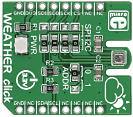
|
|
Weather click carries BME280 integrated environmental unit from Bosch. It's a sensor that detects humidity, pressure and temperature, specifically designed for low current consumption and long term stability. Those features make it ideal for applications like home automation control, personalized weather stations, sport and fitness tools and so on. The sensor has three operating modes: sleep, forced, and normal. Also, the humidity and pressure sensors can operate independently. Weather click can communicate with the target MCU either through mikroBUS SPI or I2C interfaces. The board is designed to use a 3.3V power supply. |
|
|
|
 |
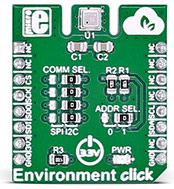
|
|
Environment click measures temperature, relative humidity, pressure and VOC (Volatile Organic compounds gases). The click carries the BME680 environmental sensor from Bosch. Environment click is designed to run on a 3.3V power supply. It communicates with the target microcontroller over SPI or I2C interface.
You can use it to test your indoor air quality, to control HVAC (heating, ventilation, and air conditioning) systems, in a weather station, sports applications and more. |
|
|
|
 |
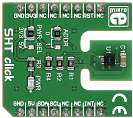
|
|
SHT click is a temperature and humidity sensing click board that carries Sensiron's SHT3x-DIS IC. Compared to its predecessor (SHT11), SHT3x click has increased reliability and enhanced signal processing features with a high signal-to-noise ratio. Best measurement results are achieved within a 5-60° temperature range (0.015 resolution) and a 20%–80% RH humidity range (0.01 resolution). SHT click outputs a fully calibrated, linearized, and temperature compensated digital output through the mikroBUS I2C interface (SCL, SDA). An additional INT pin is for setting up alerts for certain temperature or humidity values. Finally, a RST pin allows you to reset the sensor. Designed to use either 3.3V or 5V power supply. |
|
|
|
 |
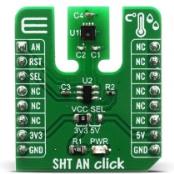
|
|
SHT AN Click is a sensorics based add on board which can be used for measuring humidity and temperature. It features fully calibrated, linearized and temperature compensated SHT31-ARP-B sensor with analog output. This sensor is built on a new technology CMOSens® sensor chip from Sensirion. What differentiate this Click board comparing to other is dual sensor analog output which can be used for measuring and calculation of the data over one analog output. This board is best suitable for the smart and low power applications which require temperature range of -40 to up to 90 °C. We have also in our offer SHT Click, which is a digital interface version of the same sensor.
SHT AN Click is supported by a mikroSDK compliant library, which includes functions that simplify software development. This Click board™ comes as a fully tested product, ready to be used on a system equipped with the mikroBUS™ socket.
|
|
|
|
 |
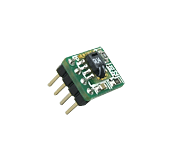
|
|
The SHT1X PROTO Board is used to connect your prototype device with a temperature/humidity sensor. It features the SHT11 sensor that uses a 2-wire serial interface, thus enabling you to measure temperature and humidity. |
|
|
|
 |
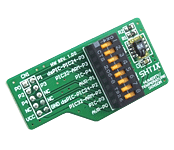
|
|
The SHT1X Board features the SHT11 sensor. It is connected to a development board through a 2-wire serial interface, thus enabling you to measure temperature and humidity. |
|
|
|
 |
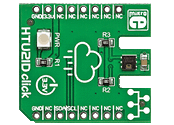
|
|
HTU21D click carries a high-precision, easy-to-use relative humidity sensor with temperature output. It's a great solution for quickly developing reliable environmental sensing nodes. The sensor is plug and play, requiring no calibration to use. The measurement range of HTU21D click is from 0 to 100 percents of relative humidity, and -40 to +125 degrees of Celsius. The board communicates with the target microcontroller through mikroBUS I2C lines: SCL (clock) and SDA (data). The default resolution of the signal is set to 12-bit for relative humidity and 14-bit for temperature readings. HTU21D click uses a 3.3V power supply. |
|
|
|
 |
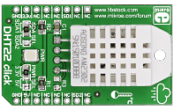
|
|
DHT22 click is a temperature and humidity measurement board carrying the sensor of the same name. It's a low cost reliable solution that communicates with the target board microcontroller through a single Serial Data Line. The sensor can detect temperatures between - 40 and 80 degrees centigrade with a half a degree precision. The relative humidity measurement from 0 - 100% is accurate within 2%. DHT22 has two jumpers. One for choosing between two mikroBUS pins (CS or INT) for communicating with the target board microcontroller. Another for setting up the power supply voltage either at 3.3V or 5V. |
|
|
|
 |

|
|
DHT22 2 click is used for measuring the environmental temperature and relative humidity. It uses the CM2322 sensor, with very accurate thermal and humidity measuring capabilities. It can use either 1-Wire or I2C protocol to communicate with the integrated circuit.
Attributes like the ultra-small size, low power consumption,data signal transmission distance up to 20 meters, make this sensor the perfect choice for all kinds of applications that require measurement of the temperature and humidity. |
|
|
|
 |
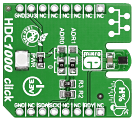
|
|
HDC1000 click is a humidity (and temperature) measurement click board carrying the HDC1000 sensor from TI. Its chief features are low power consumption, precision, and resistance to dust, dirt, and similar environmental contaminants. The relative humidity (0-100%RH) is measured with an accuracy of ±3%; the temperature is measured within a range from -20°C to 85°C with ±0.2°C accuracy. HDC1000 click communicates with the target board MCU through mikroBUS I2C and INT lines. It operates as a slave device on the I2C interface. A pair of onboard jumpers allow you to specify the slave byte address, with four to choose from. The board is designed to use a 3.3V power supply only. |
|
|
|
 |
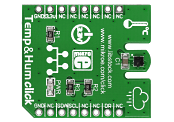
|
|
Temp&Hum click carries ST’s HTS221 temperature and relative humidity sensor. Its temperature measurement accuracy is ±1°C within a 0-60°C range. The precision is increased to ±0.5°C in a narrower range from 15 to 40°C. The highly sensitive relative humidity measurement range is from 0 to 100% with ±6% accuracy (or ±4.5% in the 20-80% range). The measurements are output in 16-bit resolution through the mikroBUS I2C interface. The board uses a 3.3V power supply. |
|
|
|
 |
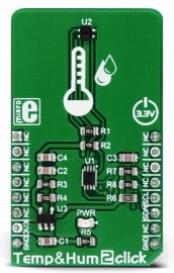
|
|
Temp-Hum 2 click is a smart temperature and humidity sensor click board™, packed with features, that allow easy and simple integration into any design that requires accurate and reliable humidity and temperature measurements. It measures a wide range of temperature and relative humidity values with a great accuracy. The Si7034 sensor IC from Silicon labs used on this Click board™ utilizes the patented industry-standard low-K polymeric dielectrics for humidity sensing. It allows low drift and, power consumption, low hysteresis, and excellent long-term stability. |
|
|
|
 |

|
|
Smart environmental temperature and humidity sensor
Temp-Hum 3 click is a smart environmental temperature and humidity sensor Click board™, packed with features which allow easy and simple integration into any design that requires accurate and reliable humidity and temperature measurements. The sensor IC has integrated sensing elements placed on the bottom of the die, so they are not directly exposed to the environmental contamination. This translates to a prolonged life of the Click board™ itself. |
|
|
|
 |

|
|
Smart environmental temperature and humidity sensor
Temp-Hum 4 click is a smart environmental temperature and humidity sensor Click board™, packed with features which allow easy and simple integration into any design that requires accurate and reliable humidity and temperature measurements. The sensor IC itself has integrated sensing elements placed on the bottom of the die, so they are not directly exposed to the environmental contamination, which translates to a prolonged life of the Click board™. |
|
|
|
 |

|
|
Temp&Hum 5 click is a temperature and humidity sensing click board™, packed with features that allow simple integration into any design. It can measure a wide range of temperature and relative humidity values with high accuracy. The Click board™ is equipped with the HIH6130 sensor, offering the complete measurement system onboard: capacitive humidity sensor, bandgap thermal sensor, signal processing, and the I2C communication interface. Featuring good reliability over time, high accuracy, and low hysteresis, it represents an ideal solution to be used in various temperature and humidity related applications.
Temp&Hum 5 click is supported by a mikroSDK compliant library, which includes functions that simplify software development. This Click board™ comes as a fully tested product, ready to be used on a system equipped with the mikroBUS™ socket.
|
|
|
|
 |
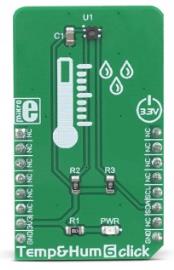
|
|
Temp&Hum 6 click is a smart temperature and humidity sensing click board™, packed with features that allow easy and simple integration into any design. It measures a wide range of temperature and relative humidity values with great accuracy. The ENS210 sensor IC used on this Click board™ is an ultra-accurate temperature and relative humidity sensor (RH), featuring very low drift, very low power consumption, small hysteresis, and excellent long-term stability. Thanks to its advanced logic back-end, the sensor IC can offer measurement readings in Kelvin and %RH directly, over the I2C interface.
Temp&Hum 6 click is supported by a mikroSDK compliant library, which includes functions that simplify software development. This Click board™ comes as a fully tested product, ready to be used on a system equipped with the mikroBUS™ socket.
|
|
|
|
 |
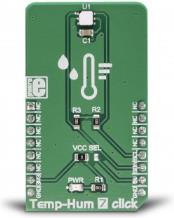
|
|
Temp&Hum 7 click is a Click board™ which is perfectly suited for measuring the relative humidity (RH) and temperature. The Click board™ is equipped with the Si7021-A20, an accurate and reliable sensor IC, packed in a miniature 3x3mm DFN package. By using the patented low-K polymeric dielectrics, this sensor is available to achieve measurements with a very low drift and hysteresis, and excellent long-term stability. Each sensor has the factory calibration parameters pre-programmed in the non-volatile memory, requiring no additional calibration by the user. this Click board™ can be used for the development of the many different relative humidity and temperature measuring applications, including weather stations, reliable monitoring systems, asset tracking, HVAC/R based applications, and more.
It comes in the package which also includes the mikroSDK™ software and a library with all the functions. The Click board™ comes as a fully tested and approved prototype, making it a reliable device ready to use on the development board.
|
|
|
|
 |
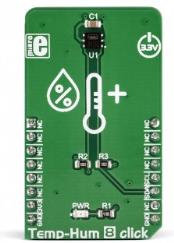
|
|
Temp&Hum 8 click is based on a sensor from the popular SHT family, designed to measure temperature and humidity. This sensor family has already become an industry standard, providing proven reliability and stability while requiring a minimum number of components, making the development of applications cheaper and faster. The sensor used on this click is labeled as SHT21, which features a high degree of measurement linearity, thanks to the factory calibration and testing which is performed for each sensor sample. Featuring high accuracy, good linearity, proven reliability, and long-term stability, you can use this sensor can for many different applications. Some of them include weather stations, various environmental data collection applications, IoT based applications, and all applications that require a reliable thermal and humidity readings over longer periods of time.
It comes in the package which also includes the mikroSDK™ software and a library with all the functions. The Click board™ comes as a fully tested and approved prototype, making it a reliable device ready to use on the development board.
|
|
|
|
 |
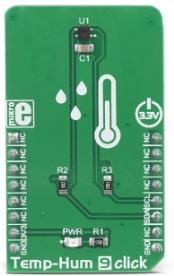
|
|
Temp-Hum 9 click is a smart temperature and humidity sensing click board™, packed with features that allow simple integration into any design. It can measure a wide range of temperature and relative humidity values with high accuracy. The SHTC3 sensors used on this Click board™ offers the complete measurement system: capacitive RH sensor, bandgap thermal sensor, analog and digital data processing, and the I2C communication interface. Featuring a good reliability over time, high accuracy, and low hysteresis, it is an ideal solution to be used in various temperature and humidity related applications.
Temp-Hum 9 click is supported by a mikroSDK compliant library, which includes functions that simplify software development. This Click board™ comes as a fully tested product, ready to be used on a system equipped with the mikroBUS™ socket.
|
|
|
|
 |
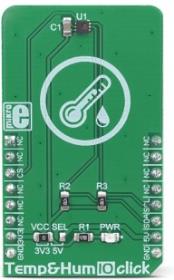
|
|
Temp&Hum 10 Click is a smart temperature and humidity sensing Click board™, aimed towards IoT applications, due to its extremely small size and very low power consumption. It can measure a wide range of temperature and relative humidity (RH) values with high accuracy. The sensor used on this Click board™ offers the complete measurement system: capacitive RH sensor, thermal sensor, analog and digital data processing, and the I2C communication interface. Featuring a good reliability over time, high accuracy, and low hysteresis, it is an ideal solution to be used in various temperature and humidity related IoT applications.
Temp&Hum 10 click is supported by a mikroSDK compliant library, which includes functions that simplify software development. This Click board™ comes as a fully tested product, ready to be used on a system equipped with the mikroBUS™ socket.
|
|
|
|
 |

|
|
Temp-hum 11 click is a temperature and humidity sensing Click board™, equipped with the HDC1080, a high accuracy digital humidity, and temperature sensor. Its key features are its low power consumption, and the measurement accuracy achieved with that much energy. The HDC1080 sensor can sense the relative humidity (RH) with the accuracy of ±2%, while the temperature can be sensed with the accuracy up to ±0.2°C. It has a 14-bit measurement resolution, and it can be operated over a wide supply voltage range, allowing it to be interfaced with both 5V and 3.3V MCUs with no additional components required.
Temp-hum 11 click is supported by a mikroSDK compliant library, which includes functions that simplify software development. This Click board™ comes as a fully tested product, ready to be used on a system equipped with the mikroBUS™ socket.
|
|
|
|
 |
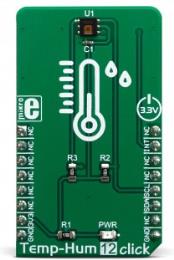
|
|
Temp&Hum 12 click is a smart environmental temperature and humidity sensor Click board™, packed with features which allow easy and simple integration into any design that requires accurate and reliable humidity and temperature measurements. The capacitive-based sensor includes new integrated digital features and a heating element to dissipate condensation and moisture. This translates to a prolonged life of the Click board™ itself.
Temp&Hum 12 click is a perfect solution for a wide range of applications that depend on accurate temperature and humidity readings. With its low power consumption and programmable interrupt requests capability, it is also a perfect choice for various temperature and relative humidity based IoT applications, smart thermostats and smart home assistants.
|
|
|
|
 |
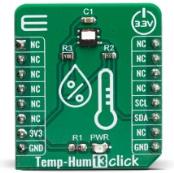
|
|
Temp&Hum 13 Click is a Click board™ which is perfectly suited for measuring the relative humidity (RH) and temperature. The Click board™ is equipped with the HTU21DF, an accurate and reliable sensor IC, packed in a miniature 3x3mm DFN package. This sensor is fully calibrated and features fast response time, low power consumption, full interchangeability with no calibration required, instantaneous desaturation after long periods in saturation phase and many more. This Click board™ can be used for the development of the many different relative humidity and temperature measuring applications, including weather stations, reliable monitoring systems, asset tracking, HVAC/R based applications, and more.
Temp&Hum 13 click is supported by a mikroSDK compliant library, which includes functions that simplify software development. This Click board™ comes as a fully tested product, ready to be used on a system equipped with the mikroBUS™ socket.
|
|
|
|
 |

|
|
THERMO Click is an accessory board in mikroBUS form factor. It features the MAX31855K thermocouple-to-digital converter as well as a PCC-SMP connector for K-type thermocouple probes. The MAX31855K measures a temperature range of between -270°C and 1372°C with a sensitivity of about 41uV/°C. It has a built-in 14-bit ADC converter. THERMO Click communicates with the target board via an SPI interface (read-only). The board is designed to use a 3.3V power supply only. It has a green LED which indicates if the board is powered. |
|
|
|
 |

|
|
THERMO K click carries the MCP9600 IC from Microchip. Depending on the type of probe it uses the click can measure temperatures from -200 °C to +1372 °C.
The click is designed to run on either a 3.3V or 5V power supply. It communicates with the target MCU via an I2C interface. |
|
|
|
 |

|
|
Thermo J click is a temperature measurement click board™, which uses a thermocouple type-J probe, connected to a PPC-SMP-J onboard connector. The active part of the Thermo J click is MCP9600 by Microchip - a thermocouple EMF to temperature converter, with 1.5°C of maximum accuracy. The onboard PCC-SMP-J connector ensures the secure connection and accurate readings for the connected thermocouple.
The main advantage of the thermocouples over some other types of temperature measuring devices, is a wide range of temperatures that they can measure. With the addition of four programmable ALERT lines routed to the mikroBUS™ pins, Thermo J click is an ideal solution for the temperature measurements in extreme conditions, hard to reach places, machinery, and similar applications.
|
|
|
|
 |
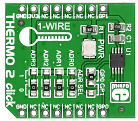
|
|
Thermo 2 click carries DS1825, a programmable resolution digital thermometer IC. It measures temperature within a range from - 10°C to 85°C with +/-0.5°C accuracy. You can specify the resolution of the measurements, from 9 to 12-bit, depending on the application. The board communicates with the target microcontroller through a 1-wire interface. Using the onboard jumper, you can choose between two mikroBUS pins for setting the output. Thermo 2 click also features four Address Select jumpers for setting a unique ID for the sensor (allowing for up to 16 sensors to operate on a single 1-Wire bus). |
|
|
|
 |
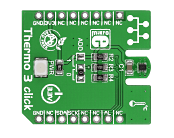
|
|
Thermo 3 click carries TMP102, a digital temperature sensor IC with a tiny footprint of only 1.6mm x 1.6mm.. Without requiring calibration, TMP102 is accurate within 0.5°C. Measurement range is between -25°C to 85°C. An integrated 12-bit ADC allows for measurement resolutions down to 0.0625°C. Thermo 3 click communicates with the target board MCU through mikroBUS I2C pins (SCL, SDA), and an additional Alert pint (INT on the default mikroBUS configuration). The board is designed to use a 3.3V power supply only. |
|
|
|
 |
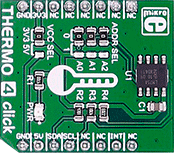
|
|
THERMO 4 click carries the LM75A digital temperature sensor and thermal watchdog. The sensor has the range from -55 °C to +125 °C. The click is designed to run on either 3.3V or 5V power supply. It communicates with the target microcontroller over I2C interface, with additional functionality provided by the INT pin on the mikroBUS™ line. |
|
|
|
 |
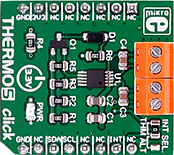
|
|
THERMO 5 click measures temperature in default range of 0°C to 127°C and extended range of -64°C to 191°C with ±1°C accuracy. It carries the EMC1414 temperature sensor. The click is designed to run on a 3.3V power supply. THERMO 5 click communicates with the target microcontroller over I2C interface, with additional functionality provided by the INT pin on the mikroBUS™ line. |
|
|
|
 |
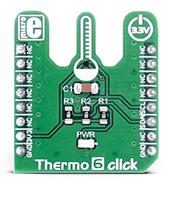
|
|
Thermo 6 click is a precise and versatile ambient temperature measurement click board™, based on the Maxim Integrated MAX31875 temperature sensor.
This sensor has a great combination of features, such as wide range of temperature measurement, excellent measuring accuracy, and small die size, coupled with the very low power consumption - attributes that make this sensor a great choice for many different applications. |
|
|
|
 |
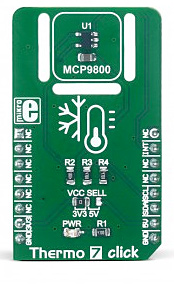
|
|
Thermo 7 click is a Click board™ equipped with the sensor IC, which can digitize temperature measurements between -55°C and +125°C so that the temperature measurement data can be processed by the host MCU. Thermo 7 click provides an accuracy of ±1°C in the range from -10°C to +85°C. The sensor used on this Click board™ has a great combination of features that make it a perfect choice for any temperature measurement application: low power consumption, selectable sampling resolution, programmable interrupt engine, compact sensor size, alert output pin, and more. The sensor itself requires almost no external components, which simplifies the design, reducing the cost and cutting the time to market. |
|
|
|
 |
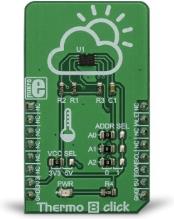
|
|
Thermo 8 click is a very accurate thermometer Click board™, with a very high typical measurement accuracy of ±0.25°C, and great data repeatability, with drift in the range of ±0.0625°C. Besides measuring the temperature, this Click board™ offers a set of very useful features, such as the thermostat function, interrupt event and critical temperature alert function. The programmable thresholds allow the user to set trigger conditions, adapting the Click board™ to any type of thermal measurement application. This Click board™ can measure a wide range of temperatures, from -20 °C, up to +100 °C.
The Click board™ is supported by a mikroSDK compliant library, which includes functions that simplify software development. The Click board™ comes as a fully tested product, ready to be used on a system equipped with a mikroBUS™ socket.
|
|
|
|
 |

|
|
Thermo 9 Click is a Click board™ equipped with the TSYS01, a digital temperature sensor from TE Connectivity. Given its main features, the Thermo 9 Click, can be used for industrial control, replacement of thermistors and NTCs, heating/cooling systems, and HVAC.
This Click board™ is supported by a mikroSDK compliant library, which includes functions that simplify software development. The Click board™ comes as a fully tested product, ready to be used on a system equipped with a mikroBUS™ socket.
|
|
|
|
 |
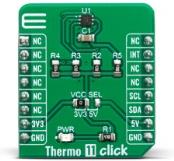
|
|
Thermo 11 Click is a Click board™ equipped with the sensor IC, which can digitize temperature measurements between -55°C and +150°C so that the temperature measurement data can be processed by the host MCU. Thermo 11 click provides an accuracy of ±0.1°C in the range from -20°C to +50°C. The sensor used on this Click board™ has a great combination of features that make it a perfect choice for any temperature measurement application: low power consumption, Selectable averaging, programmable interrupt engine, compact sensor size, interrupt output pin, and more. The sensor itself requires almost no external components, which simplifies the design, reducing the cost and cutting the time to market.
Thermo 11 click click is supported by a mikroSDK compliant library, which includes functions that simplify software development. This Click board™ comes as a fully tested product, ready to be used on a system equipped with the mikroBUS™ socket.
|
|
|
|
 |

|
|
Thermo 13 Click is a Click board™ equipped with the sensor IC, which can digitize temperature measurements between -30°C and +95°C so that the temperature measurement data can be processed by the host MCU. Thermo 13 click provides good measurement accuracy in the range from -20°C to +85°C. The sensor used on this Click board™ has a great combination of features that make it a perfect choice for any temperature measurement application: low power consumption, programmable interrupt engine, compact sensor size, interrupt output pin, and more. The sensor itself requires almost no external components, which simplifies the design, reducing the cost and cutting the time to market.
Thermo 13 click is supported by a mikroSDK compliant library, which includes functions that simplify software development. This Click board™ comes as a fully tested product, ready to be used on a system equipped with the mikroBUS™ socket.
|
|
|
|
 |
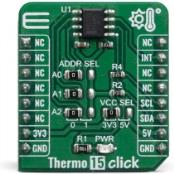
|
|
Thermo 15 Click is a Click board™ equipped with the sensor IC, which can digitize temperature measurements between -55°C and +125°C so that the temperature measurement data can be processed by the host MCU. Thermo 15 click provides an accuracy of ±1°C in the range from 0°C to 70°C. The sensor used on this Click board™ has a great combination of features that make it a perfect choice for any temperature measurement application: low temperature drift, low power consumption, programmable alert engine, compact sensor size, critical temperature warnings, and more. The sensor itself requires almost no external components, which simplifies the design, reducing the cost and cutting the time to market.
Thermo 15 click is supported by a mikroSDK compliant library, which includes functions that simplify software development. This Click board™ comes as a fully tested product, ready to be used on a system equipped with the mikroBUS™ socket.
|
|
|
|
 |
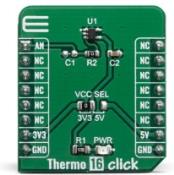
|
|
Thermo 16 Click is a Click board™ equipped with the sensor IC, which can measure temperature measurements between -40°C and +150°C so that the temperature measurement data can be processed by the host MCU. Thermo 16 click provides an accuracy of ±1°C in the range from 0°C to 70°C. The sensor used on this Click board™ has a great combination of features that make it a perfect choice for any temperature measurement application: Analog signal output, low power consumption, compact sensor size, and more. The sensor itself requires almost no external components, which simplifies the design, reducing the cost and cutting the time to market.
Thermo 16 click click is supported by a mikroSDK compliant library, which includes functions that simplify software development. This Click board™ comes as a fully tested product, ready to be used on a system equipped with the mikroBUS™ socket
|
|
|
|
 |

|
|
Thermostat click carries the MAX7502 IC digital temperature sensor, that also provides an overtemperature alarm/interrupt/shutdown output, and an SN74LVC1G126 single bus buffer from Texas Instruments. MAX7502 IC can measure temperatures from -25°C to +100°C, within the accuracy of ±1.5°C.
The G6D PCB power relay can control up to 5A, 250V AC/30V DC loads. |
|
|
|
 |

|
|
Thermostat 2 click is a general-purpose thermostat Click board™ designed to be used with any temperature sensor based on the DS1820 sensor design: 3-pin package with 1-Wire® communication interface. The Click board™ is equipped with a 3-pole terminal and a 3-pin female socket. DS1820 (or compatible) sensor can be connected either over the terminal or can be installed directly into the socket. The Click board™ also contains a high-quality relay from Omron, that can be used to open or close an electric circuit. Despite its small size, it can be used with voltage up to 30VDC/220AC and current up to 5A.
Thermostat 2 Click is supported by a mikroSDK compliant library, which includes functions that simplify software development. This Click board™ comes as a fully tested product, ready to be used on a system equipped with the mikroBUS™ socket.
|
|
|
|
 |
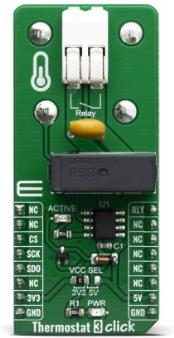
|
|
Thermostat 3 Click is a general-purpose thermostat Click board™ designed to be used with any temperature sensor based on the MAX31855 sensor design. The Click board™ is equipped with a 2-pin female socket for thermocouple connection. The K-type thermocouple can be connected directly into the socket, allowing the MAX31855 to take care of the signal-conditioning and output the absolute temperature value. The Click board™ also contains a high-quality relay from Omron, that can be used to open or close an electric circuit. Despite its small size, it can be used with voltage up to 30VDC/220AC and current up to 5A.
Thermostat 3 click is supported by a mikroSDK compliant library, which includes functions that simplify software development. This Click board™ comes as a fully tested product, ready to be used on a system equipped with the mikroBUS™ socket.
|
|
|
|
 |
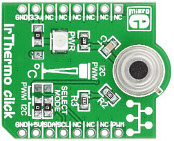
|
|
IrThermo Click features either the MLX90614ESF-BAA (3.3V) or MLX90614ESF-AAA (5V) single zone infrared thermometer module capable of non-contact temperature measurements. It is calibrated in wide temperature ranges: -40 to 85°C for the ambient temperature and -70 to +380°C for the object temperature (-20 to 120°C in PWM mode). IrThermo Click communicates with the microcontroller via mikroBUS I2C lines (SCL, SDA) or PWM line. The sensor is ideal for automotive use, industrial temperature control, body temperature measurement, movement detection, air conditioning control and more. |
|
|
|
 |
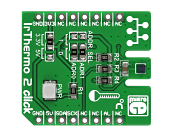
|
|
IrThermo 2 click is a non-contact temperature measurement solution. The click board carries the TMP007 infrared thermopile sensor with an integrated math engine. The sensor absorbs the infrared radiation emitted by the target object (within the sensor's field of view) and the integrated math engine calculates its temperature by comparing it with the temperature of the silicon die. The measurement range of the sensor is between -40°C to 125°C (with a 14-bit resolution). The board is designed to use either a 3.3V or a 5V power supply. |
|
|
|
 |

|
|
IrThermo 3 click is a device which allows contactless measurement of the object temperature. It uses highly advanced MLX90632 FIR sensor, which detects the average temperature of objects within its field of view (FOV), which is typically ±25°. It is factory calibrated, with the calibration constants stored in its internal EEPROM. Besides EEPROM used for storing trimming values, device settings, and calibration constants, it has additional RAM area that can be used for auxiliary measurement data storage. The integrated temperature sensor provides ambient temperature measurement, necessary for a proper calibration. The device is calibrated to sense objects with the temperature ranging from -20 ? up to 200 ?, and the ambient temperature ranging up to 80?. The measurement resolution is 0.02?. Measured data is available via the industry standard I2C communication bus. |
|
|
|
 |
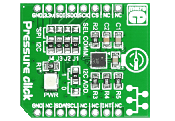
|
|
Pressure Click is a compact and easy solution for adding pressure measurement to your design. It features the LPS331AP digital output pressure sensor. The LPS331AP IC is an ultra compact absolute piezoresistive pressure sensor capable of measuring pressure (260-1260 mbar) or temperature (-40°C to 80°C) and provides a digital signal output to your microcontroller. Pressure Click communicates with the target board microcontroller via mikroBUS SPI (MOSI, MISO, SCK, CS), I2C (SDA, SCL) and INT lines. The board is designed to use a 3.3V power supply only. |
|
|
|
 |
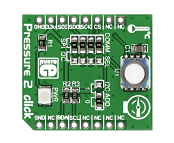
|
|
Pressure 2 click carries an MS5803, a high resolution MEMS pressure sensor that is both precise and robust. Its measurement range is from 0 to 14 bars (with a resolution of up to 0.2 mbars), but because of the stainless steel cap enclosure, the sensor can withstand up to 30 bars of pressure. Pressure 2 click communicates with the target board MCU either through mikroBUS SPI or I2C lines, depending on the position in which the onboard jumpers are soldered. |
|
|
|
 |

|
|
Pressure 3 click is a mikroBUS add-on board that carries an Infineon DPS310 digital barometric pressure sensor. It has an operating range from 300 to 1200 hPa with a relative accuracy of 0.06 hPa and absolute accuracy of 1 hPa. DPS310 is a fast sensor with typical measurement time of 27.6 ms for standard mode, down to 3.6 ms in low precision mode.
The digital measurements are in 24-bit resolution. Up to 32 results can be stored in a FIFO buffer.
Pressure 3 click has both I2C and SPI outputs. The four interface configuration buttons are soldered to mikroBUS I2C pins by default. The click uses a 3.3V power supply. |
|
|
|
 |

|
|
Pressure 4 click is an absolute barometric pressure measurement Click board™, which features a low power consumption, high precision barometric pressure sensor. Capable of using both SPI and I2C communication protocols, Pressure 4 click allows being interfaced with a broad range of various microcontroller units (MCUs). The sensor used on this Click board™ features onboard processing capabilities, such as the IIR filtering, used to filter out abrupt changes of pressure. Low power consumption allows Pressure 4 click to be used in many portable, battery-powered applications. Besides the pressure, it can also measure the ambient temperature, which can be used for the compensation calculations. |
|
|
|
 |
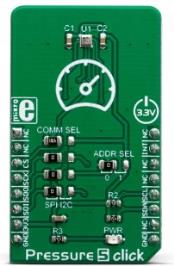
|
|
Pressure 5 click is a barometric pressure measurement Click board™, which features the BMP388, an accurate absolute barometric pressure sensor. Due to its very high sensing accuracy, it is perfectly suited for precise altitude tracking applications. The BMP388 pressure sensor can use both SPI and I2C communication protocols, allowing it to be interfaced with a broad range of MCUs. The BMP388 features onboard processing capabilities such as the IIR filtering, which can be used to filter out abrupt pressure changes. Thanks to its very low power consumption, Pressure 5 click to be used in a wide range of battery-powered and portable applications.
Pressure 5 click is supported by a mikroSDK compliant library, which includes functions that simplify software development. This Click board™ comes as a fully tested product, ready to be used on a system equipped with the mikroBUS™ socket.
|
|
|
|
 |
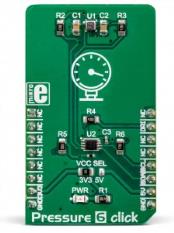
|
|
Pressure 6 click features a simple, yet highly accurate and reliable pressure sensor labeled as BM1386GLV, produced by ROHM. This sensor is a piezo-resistive pressure sensor with internal thermal compensation, which greatly simplifies the pressure reading. Pressure 6 click allows readings in the range from 300hPa up to 1300hPa, with the accuracy of ±0.12hPa. The Click board™ comes as a fully tested and approved prototype, making it a reliable device ready to use on the development board. The full package also includes the mikroSDK™ software and a library with all the functions.
The click is perfect to use for developing the industry-related applications, as well as in the healthcare applications, mobile devices, smartphone apps, and similar.
|
|
|
|
 |
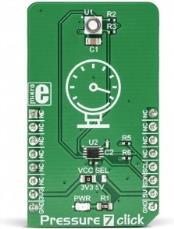
|
|
Pressure 7 click features an integrated digital barometric pressure and temperature sensor labeled as MS5837. This sensor relies on the advanced MEMS technology by MEAS Switzerland, a well-known high-volume MEMS manufacturer. It is a high-resolution pressure sensor, with offers 24-bit pressure and thermal data over the I2C interface. Each sensor is factory calibrated, with the compensation parameters stored within its internal PROM memory. A hermetically sealed stainless-steel body filled with the protective gel ensures high reliability and mechanical endurance of the sensor. A high-speed conversion, long-term stability, high resolution, low count of external components required, and a wide range of MCUs that can it can be interfaced with, make for just some of the benefits of the Pressure 7 click.
It comes in the package which also includes the mikroSDK™ software and a library with all the functions. The Click board™ comes as a fully tested and approved prototype, making it a reliable device ready to use on the development board.
|
|
|
|
 |
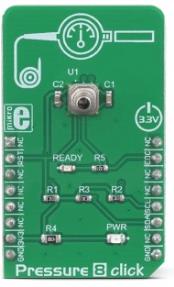
|
|
Pressure 8 Click is an accurate and fully calibrated pressure sensor, equipped with the MPR series integrated piezoresistive silicon pressure sensor IC. This sensor offers many benefits, including low power consumption, high resolution of the output data (24 bit), stainless steel housing, compatibility with a variety of liquid media, high accuracy over a wide range of temperatures… The most distinctive feature of these sensors is its ability to output calibrated and compensated 24-bit data over a digital interface, which greatly simplifies the software design, cutting the time to market.
Pressure 8 click is supported by a mikroSDK compliant library, which includes functions that simplify software development. This Click board™ comes as a fully tested product, ready to be used on a system equipped with the mikroBUS™ socket.
|
|
|
|
 |

|
|
Pressure 9 click is a digital barometric air pressure sensor Click board™. It is equipped with the DPS422, barometric air pressure sensor, based on a capacitive sensor element. Besides the pressure, this sensor can also measure temperature. Measurement data is available over the I2C or SPI interface, along with the factory calibrated coefficients, used for high-accuracy data conversion. The device also features 32 words-long FIFO buffer, low power consumption, and very high precision, thanks to an integrated 24-bit A/D converter. It can be used within the pressure range from 300 to 1200hPa and temperature in the range from -40°C to +85°C.
Pressure 9 Click is supported by a mikroSDK compliant library, which includes functions that simplify software development. This Click board™ comes as a fully tested product, ready to be used on a system equipped with the mikroBUS™ socket.
|
|
|
|
 |
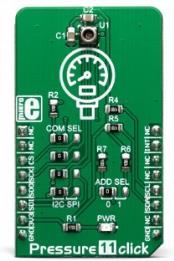
|
|
Pressure 11 Click is a digital barometer on a Click board™. Pressure 11 is equipped with the LPS33HW, an absolute piezoresistive pressure sensor, manufactured using a proprietary technology. This sensor offers many benefits, including low power consumption, high resolution of the pressure data, embedded thermal compensation, FIFO buffer with several operating modes, temperature measurement, etc. The most distinctive feature of this sensor is its ability to measure the pressure within the wide range between 260 - 1260hPa, offering calibrated readings over the SPI or I2C digital interface.
Pressure 11 Click is supported by a mikroSDK compliant library, which includes functions that simplify software development. This Click board™ comes as a fully tested product, ready to be used on a system equipped with the mikroBUS™ socket.
|
|
|
|
 |
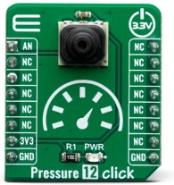
|
|
Pressure 12 click is a barometric gauge pressure measuring Click board™, equipped with the Amplified Basic Pressure sensor series (ABP), which features a ratiometric analog output, which is proportional to the applied pressure. It features a very low Total Error Band of 1.5% of FS, a specification used to describe all the measurement errors and deviations within the sensor itself. The ABP series sensor uses a calibrated and thermally compensated ASIC, providing a ratiometric output updated at a frequency of 1kHz. It can be directly used by the A/D conversion section of the host MCU, but it can also be directly used in a control feedback loop, for low latency operations.
Pressure 12 click is supported by a mikroSDK compliant library, which includes functions that simplify software development. This Click board™ comes as a fully tested product, ready to be used on a system equipped with the mikroBUS™ socket.
|
|
|
|
 |
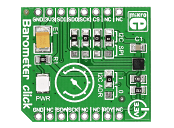
|
|
Barometer click carries the LPS25HB IC, which is a piezoresistive absolute pressure sensor with a measurement range from 260 to 1260 hPa (with a 24-bit resolution output). It's a high precision sensor and high resolution mode it can measure pressure within 0.01 hPa RMS. A low resolution mode can be implemented to reduce power consumption. Barometer click can communicate with the target board MCU either through I2C or SPI pins (which is specified by soldering onboard jumpers in appropriate position). An interrupt pin is also available, which can be configured either as Data Ready (sends signal when pressure value changes) or as a threshold trigger (sends signal when specified high or low pressure value is reached). The board uses a 3.3V power supply only. |
|
|
|
 |
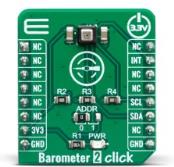
|
|
Barometer 2 Click is a digital barometer on a Click board™. Barometer 2 is equipped with the LPS35HW, an absolute piezoresistive pressure sensor with ceramic, water resistant package, manufactured using a proprietary technology. This sensor offers many benefits, including low power consumption, high resolution of the pressure data, embedded thermal compensation, FIFO buffer with several operating modes, temperature measurement, etc. The most distinctive feature of this sensor is its ability to measure the pressure within the wide range between 260 - 1260hPa, offering calibrated readings over I2C digital interface.
Barometer 2 Click is supported by a mikroSDK compliant library, which includes functions that simplify software development. This Click board™ comes as a fully tested product, ready to be used on a system equipped with the mikroBUS™ socket.
|
|
|
|
 |

|
|
Altitude click features the MPL3115A2 MEMS pressure sensor, which provides accurate pressure/altitude (20-bit) and temperature (12-bit) data. Resolution is down to 30 cm (1.5 Pa). The MPL3115A2 contains automatic internal data processing with data acquisition and compensation. It features a 32 sample FIFO buffer to minimize the overhead of collecting multiple data samples. It can autonomously collect data at programmed intervals and store it up to 12 days depending on data acquisition rate (1 second - 9 hours). The board uses an I2C communication interface and is designed to use a 3.3V power supply only. |
|
|
|
 |

|
|
Altitude 2 click is a high-resolution barometric pressure sensor Click board™. It provides very accurate measurements of temperature and atmospheric pressure, which can be used to calculate the altitude with a very high resolution of 20cm per step. Besides that, the device also includes features such as the ultra-low noise delta-sigma 24bit ADC, low power consumption, fast conversion times, pre-programmed unique compensation values, and more. Low count of external components requirement, along with the simple interface which requires no extensive configuration programming, makes this sensor very attractive for building altitude or air pressure measuring applications. |
|
|
|
 |

|
|
Altitude 3 click allows high-resolution barometric pressure measurement, by utilizing the ICP-10100, an integrated barometric pressure and temperature sensor. Based on the advanced MEMS capacitive sensing technology, it offers an industry-level accuracy and thermal stability. A very high absolute pressure accuracy up to ±1 Pa allows Altitude 3 click to sense very small altitude changes, within the magnitude of about 10 cm. The temperature sensor offers accuracy up to ±0.4°C, in the range from -40°C to 85°C. Low power requirements make it a perfect choice for various battery-operated applications.
Altitude 3 click is supported by a mikroSDK compliant library, which includes functions that simplify software development. This Click board™ comes as a fully tested product, ready to be used on a system equipped with the mikroBUS™ socket.
|
|
|
|
 |
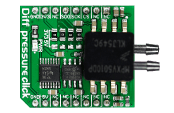
|
|
Diff pressure click is a mikroBUS add-on board carrying an NXP MPXV5010DP signal conditioned, temperature compensated and calibrated pressure sensor with two axial ports to accommodate industrial grade tubing. It is designed for comparing two pressure measurements.
The two ports are designated as Pressure side (P1) and Vacuum side (P2). The sensor is designed to operate with a positive differential pressure where P1 > P2. The measurement range is from 0 to 10 kPa. In the temperature range between 0º and 85ºC, the sensor has a maximum error rate of 5.0%.
MPXV5010DP IC has an analog output. The signal passes through the onboard 22-bit ADC before being outputted through the mikroBUS SPI interface (CS, SCK, MISO).
Diff pressure click is designed to use either a 3.3V or a 5V power supply |
|
|
|
 |
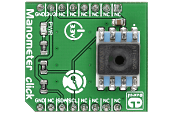
|
|
Manometer click is an add-on board with a piezoresistive silicon pressure sensor. The onboard Honeywell HSCMAND060PA3A3 module has an industry-leading, extremely high accuracy of ±0.25%FSS BFSL. An absolute pressure range from 0 to 60 PSI makes it suitable for a variety applications. Beyond the measurement range, the sensor has a high burst pressure threshold, resulting in increased reliability. The barbed port accepts 4.93 mm (0.19") tubing. Manometer click communicates with the target board MCU through the mikroBUS I2C interface (SCL, SDA). Manometer click uses a 3.3V power supply. |
|
|
|
 |
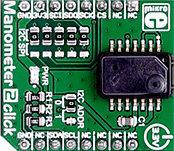
|
|
Manometer 2 click carries the MS5525DSO-SB001GS digital pressure sensor, based on leading MEMS technology. The click is designed to run on a 3.3V power supply. It communicates with the target microcontroller over I2C or SPI interface. |
|
|
|
 |
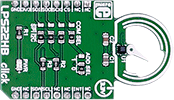
|
|
LPS22HB click is an easy solution for adding a digital barometer to your design. It carries the LPS22HB MEMS nano pressure sensor. The click is designed to run on a 3.3V power supply. LPS22HB click communicates with the target microcontroller over I2C or SPI interface. |
|
|
|
 |
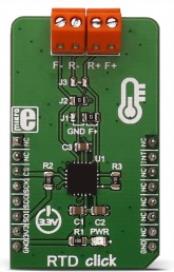
|
|
RTD click is based on MAX31865 resistance to digital converter from Maxim Integrated, optimized for platinum resistance temperature detectors, or RTD. The click uses the PT100 type platinum probe for temperature measurement. There are four screw terminals on the board, so different PT100 probe types can be used with this design. This click board™ can work with 2, 3 or 4-wire PT100 probe types.
RTD probes are commonly used to measure a range of temperatures between -200°C and 500°C, but the exact value depends on the specific probes used. Features like the 15bit ADC resolution, input terminals overvoltage protection up to ±45V, fault detection, fast response time of 21mS and the SPI interface, make the RTD click an ideal solution when it comes to precise measuring of extremely high and low temperatures. |
|
|
|
 |
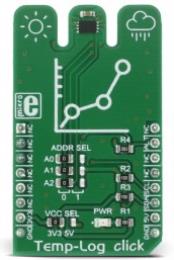
|
|
Temp-Log click is a precise ambient temperature measurement device, equipped with 8Kbit (1024 bytes) of EEPROM memory, which can be used to permanently store system configuration or log application specific or user preference data. This click covers a range of temperatures from -55°C to +125°C with the highest accuracy of ±0.5°C, in the range of 0°C to 85°C. The device can also send an ALERT signal to the INT pin of the mikroBUS™ every time programmed temperature thresholds are reached.
Besides the EEPROM, the device also contains non-volatile configuration register, which is copied to the main configuration register after every restart of the device. This allows for near-autonomous operation of the device, without the need to initialize the sensor configuration parameters after every power cycle. These features make the Temp-Log click a perfect choice for temperature measurement in a wide variety of communication, consumer, computer, industrial and similar applications, with an addition of up to 8Kbit of user data storage space. |
|
|
|
 |
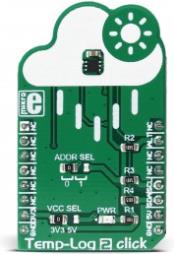
|
|
Temp-Log 2 click is a precise ambient temperature measurement device, equipped with the additional non-volatile (EEPROM) memory that can be used to permanently store system configuration, and 64 bits of general-purpose EEPROM, used for logging application specific or user preference data. This click covers a range of temperatures from -55°C to +125°C with the highest accuracy of ±0.2°C, in the range of -10°C to 85°C, exceeding the accuracy of CLASS A RTD. The device can also send an ALERT signal to the INT pin of the mikroBUS™ every time programmed temperature thresholds are exceeded. |
|
|
|
 |

|
|
Temp-Log 3 click is a temperature measuring Click board™ featuring the MCP9843 IC, an accurate temperature sensor IC with integrated EEPROM. Besides the thermal sensor, this IC is equipped with additional 256 bytes of EEPROM. This can be a very useful option for some applications: it allows any data to be stored within the same IC, so no additional EEPROM IC is required. This can simplify the design, reducing the number of additional components. The thermal sensor itself includes some great features such as the programmable interrupt engine, measurement range from -20°C to +125°C, accuracy up to ±1°C typically, and more.
Temp-Log 3 click is supported by a mikroSDK compliant library, which includes functions that simplify software development. This Click board™ comes as a fully tested product, ready to be used on a system equipped with the mikroBUS™ socket.
|
|
|
|
 |
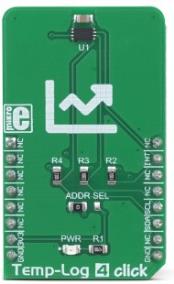
|
|
Temp-Log 4 Click is a temperature measuring Click board™ featuring the SE97B IC, an accurate temperature sensor IC with integrated EEPROM. Besides the thermal sensor, this IC is equipped with additional 256 bytes of EEPROM, integrated on the same die. This can be a very useful option for some applications: it allows auxiliary data to be stored within the same IC, so no additional EEPROM IC is required. This can simplify the design greatly, reducing the number of required external components.
This Click board™ is supported by a mikroSDK compliant library, which includes functions that simplify software development. Temp-Log 4 click comes as a fully tested product, ready to be used on a system equipped with a mikroBUS™ socket.
|
|
|
|
 |
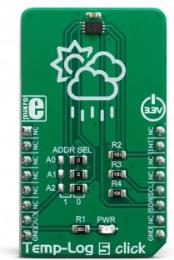
|
|
Temp-Log 5 click is a temperature measuring Click board™ featuring the CAT34TS02, an accurate temperature sensor IC with integrated Serial Presence Detect EEPROM. Temperature Sensor measures and store temperatures at least 10 times in second. Temperature measurement results can be retrieved by the host MCU via I2C interface, and are compared to critical limits stored into internal registers. It also features programmable event output function and supports three modes.
Temp-log 5 click is supported by a mikroSDK compliant library, which includes functions that simplify software development. This Click board™ comes as a fully tested product, ready to be used on a system equipped with the mikroBUS™ socket.
|
|
|
|
 |

|
|
Temp-Log 6 click is a temperature sensing Click board™, which features the MAX6642, a specifically designed IC, capable of measuring its own die temperature, as well as a temperature at a remote PN junction. This option makes Temp-Log 6 click well-suited for monitoring the temperature of a CPU, GPU or FPGA, where the PN junction is typically a substrate PNP transistor on the die of the measured IC. Instead of measuring the PN junction of a specifically designed IC, Temp-Log 6 click can also use an external diode or a small-signal transistor. The MAX6642 can also report an ALERT signal if programmed temperature thresholds are exceeded.
Temp-Log 6 click is supported by a mikroSDK compliant library, which includes functions that simplify software development. This Click board™ comes as a fully tested product, ready to be used on a system equipped with the mikroBUS™ socket.
|
|
|
|
 |

|
|
IR Grid click is a thermal imaging sensor. It has an array of 64 very sensitive factory calibrated IR elements (pixels), arranged in 4 rows of 16 pixels, each measuring an object temperature up to 300°C within its local Field of View (FOV). The MLX90621BAD IR sensor used on this Click board™ has only four pins, and it is mounted inside of the industry standard TO39 package. It is equipped with 2Kbit of EEPROM for storing the compensation and calibration parameters. The MLX90621BAD IR sensor array IC has I2C compatible digital interface, allowing it to be interfaced with a wide range of different MCUs. The sensor used on this Click board™ offers 40° x 10° FOV. The sensor can output up to 512 frames per second (FPS). |
|
|
|
 |

|
|
IR Grid 2 click is a thermal imaging sensor. It has an array of 768 very sensitive factory calibrated IR elements (pixels), arranged in 32 rows of 24 pixels. Each one of them is measuring an object temperature up to 300°C within its local Field of View (FOV). The MLX90640 IR sensor used on this Click board™ has just four pins, and it is mounted inside of the industry standard TO39 package. It is equipped with 2Kbit of EEPROM for storing the compensation and calibration parameters. The MLX90640 IR sensor array IC has I2C compatible digital interface, allowing it to be interfaced with a wide range of different MCUs. The sensor used on this Click board™ offers a summed field of view of 55°. The sensor can output up to 64 frames per second (FPS). |
|
|
|
 |

|
|
IR Grid 3 click is a thermal imaging sensor. It has an array of 768 very sensitive, factory calibrated IR elements (pixels), arranged in 32 rows of 24 pixels, each measuring an object temperature up to 300°C within its local Field of View (FOV). The MLX90640-BAA IR sensor used on this Click board™ has only four pins, and it is mounted inside of the industry standard TO39 package. The Click board™ comes as a fully tested and approved prototype, making it a reliable device ready to use on the development board. The full package also includes the mikroSDK™ software and a library with all the functions.
The click board™ is suitable for a wide range of applications, including thermal scanners, precise contactless thermal measurement, thermal leaks in homes, industrial temperature control of moving parts, other types of heated object localization, human presence, and similar applications that require accurate contactless thermal measurement, or thermal imaging.
|
|
|
|
 |
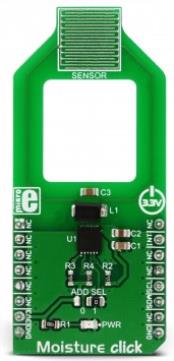
|
|
Moisture click is a Click board™ that can be used to easily detect a moisture level of the skin, by simply touching the sensitive surface of the PCB. The Click board™ is equipped with the printed copper trace sensor, which is sampled by the accurate FDC2112 IC, a 12bit capacitance to digital (FDC) converter, which employs innovative noise and EMI resistant capacitance measuring techniques. This sensor allows the Click board™ to measure the skin moisture by measuring its capacitance, which changes depending on the skin moisture level (hydration state of the outer epidermis). |
|
|
|
 |

|
|
Vacuum click is an accurate pressure sensor click board™ that is capable of measuring pressure values down to -115kPa. This click board™ utilizes a very precise, absolute pressure-sensor from NXP, labeled as MPXV6115V. This piezo-resistive transducer is an advanced monolithic pressure sensor, which combines the advanced MEMS manufacturing technologies with the integrated signal processing, providing accurate readings of the vacuum percentage, with very low drift over temperature. The sensor itself offers an analog voltage on its output pin, which linearly depends on the applied vacuum percentage. By utilizing the analog to digital converter, the Click board™ is able to output digital readings on the I2C pins, offering additional options for reading the sensor data. |
|
|
|
 |
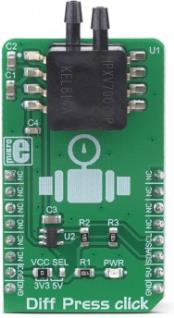
|
|
Diff Press Click is an accurate pressure sensor Click board™ capable of measuring differential pressure. This Click board™ utilizes a very precise differential pressure sensor from NXP, labeled as MPXV7007DP. This piezo-resistive transducer is an advanced monolithic pressure sensor, combining advanced MEMS manufacturing technologies with on-chip signal processing, providing accurate measurement with very low drift over temperature. The sensor outputs an analog voltage, linearly dependent on the applied pressure. This voltage is digitized by an accurate A/D converter and delivered over the I2C interface.
|
|
|
|
 |
|
|
 |

|
|
Remote Temp Click is a temperature sensing Click board™, which features the EMC1833 from Microchip, a specifically designed IC, capable of measuring remote temperature. This option makes Remote Temp click well-suited for monitoring the temperature of a CPU, GPU or FPGA, where the BJT model junction can be a substrate PNP or NPN. Remote Temp click can be configured to measure a CPU substrate transistor, a discrete 2N3904 thermal diode, or CPU/GPU processor diode. The diodes can be connected as indicated in the figure below. The EMC1833 can also report an ALERT signal if programmed temperature thresholds are exceeded.
Remote Temp click is supported by a mikroSDK compliant library, which includes functions that simplify software development. This Click board™ comes as a fully tested product, ready to be used on a system equipped with the mikroBUS™ socket.
|
|
|
|
 |

|
|
PIR Click is a pyroelectric sensor which generates a voltage when exposed to infrared radiation emitted by live bodies. It is equipped with the PL-N823-01, an infrared sensor from KEMET that uses the pyrolectric effect of ceramic by absorbing infrared rays emitted from the human body, while the the white plastic Fresnel lens covering the sensor filters visible light. This detects the natural infrared signature produced by humans. However, it can also detect infrared rays without using lenses.
PIR click is supported by a mikroSDK compliant library, which includes functions that simplify software development. This Click board™ comes as a fully tested product, ready to be used on a system equipped with the mikroBUS™ socket.
|
|
|
|
 |
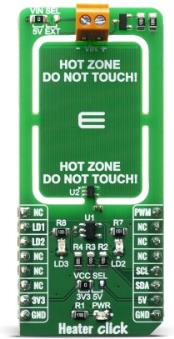
|
|
Heater Click is designed with intention of PCB heater concept testing and useful tool for heating complete casing where staying in specified temperature range is crucial. Exact PCB temperature can be set and controlled using TMP235 on board temperature sensor from Texas Instruments. Heater Click is useful tool for some projects and products that require some kind of heating, whether to prevent electronics from becoming too cold, to help control humidity, to heat up a substance, or even to prevent one material from sticking to another.
Heater Click board™ is supported by a mikroSDK compliant library, which includes functions that simplify software development. This Click board™ comes as a fully tested product, ready to be used on a system equipped with the mikroBUS™ socket.
|
|
|
|
 |
|

